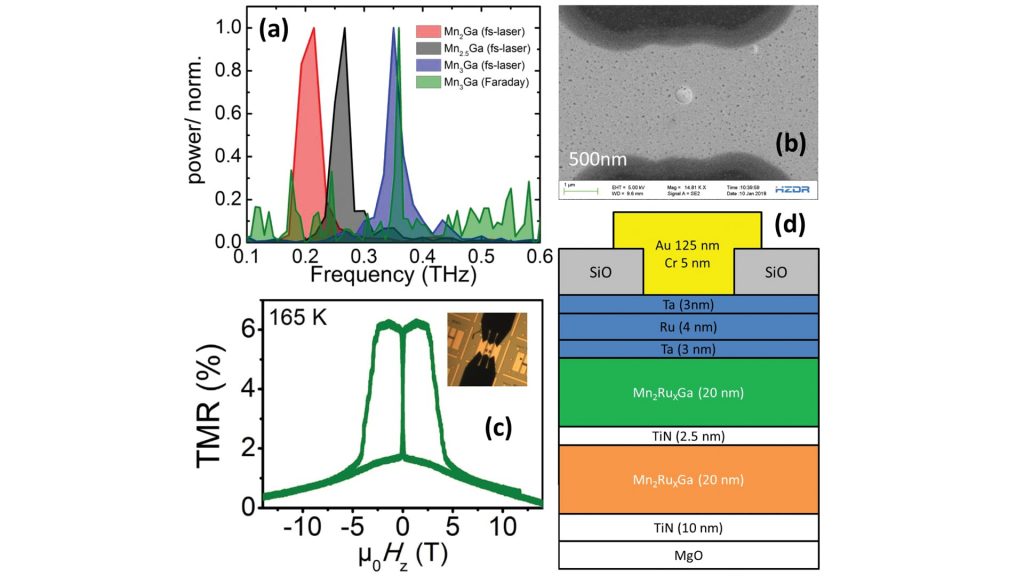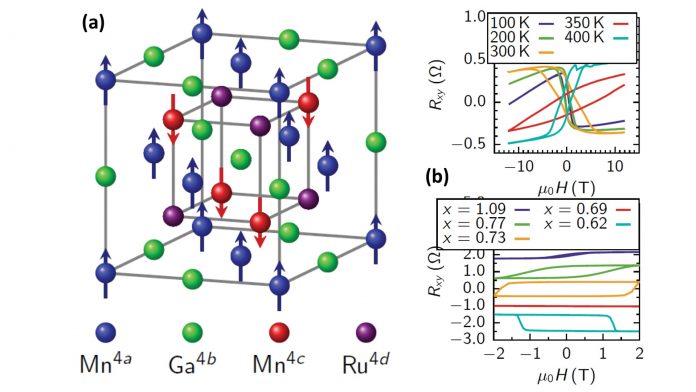Researchers at Trinity College Dublin, the Helmholdz Zentrum Dresden Rossendorf, the Norwegian University of Science and Technology, and the company Swissto12 attack the problem of efficient generation and detection of low-power THz radiation with clever, highly spin-polarised compensated ferrimagnets.
Society’s thirst for communication bandwidth is hard to quench. Present and future technological and societal challenges require regular transfers of vast amounts of data at speeds currently not available due to a lack of technology operating in the terahertz (THz) gap. The areas range from remote hospitals through personal and substance security screening, medical spectrometry and imaging to geophysical and atmospheric research. The European Commission FET Open project TRANSPIRE develops new nano-scale THz oscillators, based on a new class of magnetic materials, which are able to provide functionality in this exact range and meet these demands. Only small, efficient and, at the same time, low-cost nano-oscillators can enable new functionalities with high societal impact.
It all starts with a material – in this case something of a conundrum – a magnetic material with very low or no net moment, which nevertheless is highly spin-polarised as far as conduction electrons (close to the Fermi level) are concerned. Such a material was envisaged about 30 years back by theoreticians Val Leuken and de Groot, who wrongly called it a ‘half-metallic antiferromagnet’. Antiferromagnets surely are completely insensitive to all but the strongest external fields, and their spin dynamics is extremely fast due to its dependence on the exchange field (the essentially electrostatic interaction keeping the spins lined up). They do, however, come with one fundamental limitation: their spin polarisation must be zero on the lengthscale of a crystalline (and magnetic) unit cell, as the sublattices differ only by the direction of their magnetic moments. This is certainly not the case, however, for compensated ferrimagnets, where the two sublattices are either chemically or structurally different (or both).
The new class magnetic materials
The first experimental example of this new class of materials was found by the Trinity College Dublin group in 2014 and is Mn2Ru0.5Ga – MRG for short. In MRG, the two magentic sublattices (see Fig. 1a) are both composed of Mn, but crucially they are not equivalent and do not occupy the same crystallographic positions. Perfect compensation of the two sublattices is therefore possible, resulting in zero net moment, while the Fermi level spin polarisation is maximised and close to complete. This experimental demonstration has enabled a number of further studies, both of fundamental and applied nature. The high spin polarisation has some (to name just two) rather practical consequences:
-
- Magnetic domains can be imaged in MRG as they can be in ferromagnets using the magneto-optical Kerr effect, even when the material is compensated; and
- Magnetoresitive effects, such as anomalous Hall effect, tunnel and/or giant magnetoresistance, can be used to read out the magnetic state (say sublattice 4a pointing up or down) even in the case where the net moment (M4a + M4c) is zero (Fig. 4b).
The compositional tunability of this type of structure allows for the operational temperature range to be strategically positioned below, at or above room temperature, making the material immune to magnetic inductions of several tesla. As a long-range-ordered magnetic material, MRG is also rather insensitive to ionising radiation – a welcome bonus.
Having just a very tunable material is not sufficient for producing THz oscillators. One must be able to demonstrate that the material is able to support resonances in the THz region, while being incorporated in stacks and structures that exhibit sizable magnetoresistive effects (say 10-50%) and can sustain current densities of the order of 1010 Am-2, when patterned down to below 500nm in lateral size. Finally, it must all tie-in together, via the so-called ‘spin-transfer torque’ (STT) effect – passing large current densities through the patterned stack (pillar) should result in one sublattice exerting torque on the other, changing their mutual orientation and thus exciting the material into resonance and modulating the resistance and therefore the voltage developed across the pillar and generating THz waves. TRANSPIRE is targeting just that – producing the materials and structures, tuning their resonant properties and advancing the fundamental understanding of STT in two-sub-lattice systems.
The number one parameter of magnetisation dynamics is the magnetic resonance frequency. This is proportional to an effective field (in ferrimagnets the complicated sum of externally applied magnetic field, demagnetisation field, anisotropy and exchange) as f = γHeff with γ ~ 28GHz/T. To generate THz frequencies, one would like to either provide for an effective magnetic induction of above 10T (providing these field magnitudes externally, while possible experimentally in a lab, is not very practical on a chip) or to utilise a combination of relatively low moment, sizeable anisotropy and exchange to do just the same.
One can expect in ferrimagnets to find at least two distinct modes – first, a mode where the two sublattices precess together without changing the angle between them. This is the ferrimagnetic equivalent of the in-phase mode of coupled mechanical pendula. The second mode, where the angle between the two sublattices does change, is more energetic (therefore going much higher in frequency), but requires that the two sublattices are rather evenly matched. In order to generate spin dynamics at several 100s of GHz or even deeper into the THz region, one therefore needs materials with high anisotropy and low overall moment.
The Mn-bearing Heusler alloys crystallising in the D022 crystal structure are therefore an almost perfect choice: their crystal structure is highly tetragonal, yielding anisotropy constant Ku as high as 2MJ/m3, while the moments on the two Mn sites compensate each other to give net magnetisation as low as 250kA/m. These allows these Mn-heuslers to resonate at frequencies of 0.2 – 0.3THz and beyond (Fig. 2a see image below). There is also a much welcome side effect – the most important parameter for any material to be used in spin electronics is its spin polarisation, which jumps from the usual values for traditional ferromagnets like iron or cobalt, or about 40%, to upwards of 60% (100% being at least a theoretical possibility for these systems).
Constructing stacks and patterning nano-pillars from the D022 class of Mn-containg Heusler alloys has already been demonstrated by TRANSPIRE (Fig. 2b), be it with efficiencies needing some improvement for practical demonstrations. The detection via magnetoresistive effects such as the tunnelling magneto-resistance effect is already on the way (as shown on Fig. 2c), while much more conductive giant magnetoresistive stacks are being developed (Fig. 2d) to accommodate the current densities required for critical oscillations at several 100s of GHz.
The breakthrough objective of a low-cost, compact, reliable, room-temperature terahertz technology has a huge potential, including on-chip and chip-to-chip data links. The natural outcome of the foundational work of TRANSPIRE will be to empower a number of high-potential actors to judge on the viability of spintronic terahertz technology and to be at the forefront of research, thus ensuring future industrial European leadership on the world stage. TRANSPIRE relies on co-ordinated interdisciplinary research in physics, chemistry, materials science, terahertz design, and device engineering to ensure the success of this inherently high-risk endeavour, which can underpin the next wave of the big data revolution.
References
- H Kurt et al. Phys Rev Lett. 112, 027201 (2014); https://doi.org/10.1103/PhysRevLett.112.027201
- N Awari et al. IEEE Explore; https://doi.org/10.1109/IRMMW-THz.2016.7758831
- D Betto et al. AIP Advances. 6, 055601 (2016); https://doi.org/10.1063/1.4943756
- D Betto et al. Phys Rev B. 96, 024408 (2017); https://doi.org/10.1103/PhysRevB.96.02440
Assistant Professor Plamen Stamenov
Project Leader
Dr Karsten Rode
Work Package Leader
School of Physics and CRANN
Trinity College Dublin
stamenop@tcd.ie
rodek@tcd.ie







